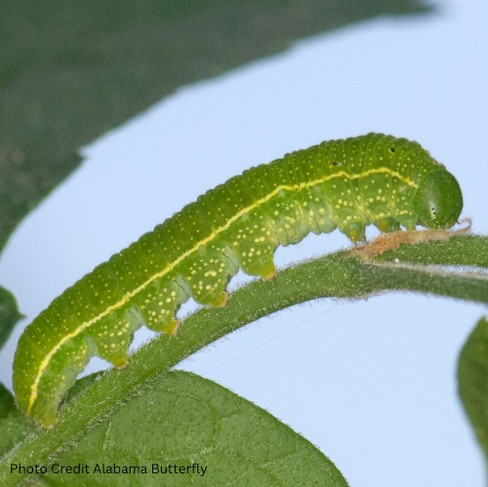Beneficial Bugs: Snout Butterfly
- Groton Garden Club
- Dec 3, 2024
- 3 min read

The Snout Butterfly (Libytheana carinenta) is a charming and distinctive butterfly species native to North and Central America. They have a wide distribution ranging from the southern United States up to Canada and extending into parts of Mexico and Central America. Its name is derived from the elongated protrusion on its face, resembling a "snout," which is a unique feature among butterflies setting it apart from many other species in its family.
Its most prominent characteristic is the elongated proboscis or "snout" protruding from its head, which resembles the elongated mouthparts of certain moths. The wingspan of the Snout Butterfly typically ranges from 1.5 to 2.5 inches and are primarily brownish-gray, often with darker markings and a mottled pattern that aids in camouflage. Both the forewings and hindwings of the Snout Butterfly are relatively broad and rounded, giving it a gentle and graceful appearance when in flight.
Snout Butterflies are commonly found in open woodland areas, meadows, and grasslands across North and Central America. They prefer habitats where their larval host plants, particularly hackberry (Celtis spp.), grow abundantly. As adults, Snout Butterflies are active during the day (diurnal) and can often be seen fluttering among flowers in search of nectar.
Like all butterflies, the Snout Butterfly undergoes a complete metamorphosis consisting of four stages: egg, larva (caterpillar), pupa (chrysalis), and adult. The female Snout Butterfly lays her eggs on the leaves of host plants, typically hackberry trees. Upon hatching, the caterpillars feed on the leaves until they are ready to pupate. The pupal stage lasts for a variable period, depending on environmental conditions, after which the adult butterfly emerges from the chrysalis ready to mate and continue the life cycle.
Mature Snout Butterfly caterpillars typically have a cylindrical body covered in fine hairs, with a segmented appearance. The coloration may vary, but they often display shades of green or brown, providing camouflage among the leaves of their host plants. Along the sides of the caterpillar's body, there are usually rows of small, protruding tubercles or bumps. These may be adorned with tiny spines or hairs. The head of the Snout Butterfly caterpillar is usually small compared to the body, with a pair of short antennae and chewing mouthparts adapted for feeding on leaves.
As adults, Snout Butterflies primarily feed on nectar from a variety of flowering plants. They are particularly attracted to plants such as milkweed, thistles, and aster, among others. Their elongated mouthparts, adapted for feeding on tubular flowers, allow them to extract nectar efficiently. Additionally, Snout Butterflies are known to engage in mud-puddling behavior, where they gather on damp soil or mud to extract essential minerals and nutrients.
Snout Butterflies play a vital role in their ecosystems. Their presence in gardens and natural habitats contributes to the overall health and balance of ecosystems, making them an important component of biodiversity conservation efforts.
Pollination: As they visit flowers for nectar, Snout Butterflies inadvertently transfer pollen from one flower to another, facilitating plant reproduction. This pollination service is essential to produce fruits, vegetables, and seeds in garden plants.
Biodiversity: By attracting Snout Butterflies to your garden, you contribute to the overall biodiversity of the area. Supporting diverse insect populations helps maintain a healthy ecosystem, which benefits other wildlife and plants.
Natural Pest Control: Adult Snout Butterflies are not considered significant pest insects. However, by fostering a diverse ecosystem that includes butterflies, you may attract natural predators of pest insects, such as certain species of birds and predatory insects, which can help keep pest populations in check without the need for chemical pesticides. Additionally, Snout Butterflies serve as prey for various predators, including birds and other insects, thus supporting a balanced food web.
The Snout Butterfly, with its unique appearance and ecological role, is a welcome addition to gardens in Groton, offering pollination services, promoting biodiversity, aiding in natural pest control, and providing educational value to enthusiasts of all ages. By creating a welcoming habitat for these butterflies, gardeners can contribute to the health and vibrancy of their local ecosystem.

















Comments